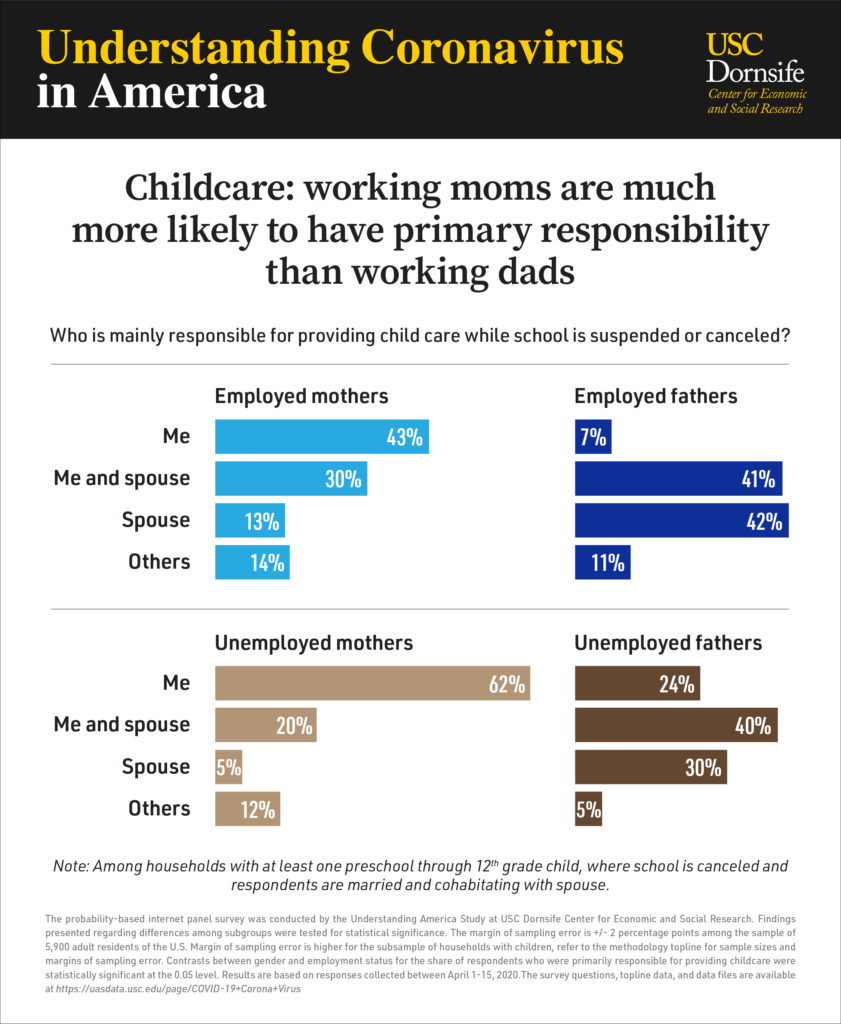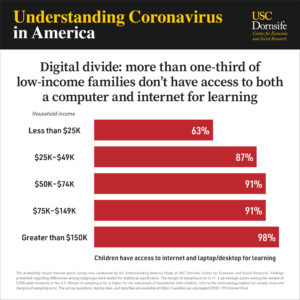USC Dornsife’s “Understanding Coronavirus in America” study reveals that school-age children in nearly 9-in-10 households are engaged in educational activities provided by their school. While the study shows parents in nearly 8-in-10 households are satisfied with school communication, there are signs of challenges on the horizon.
Contact: Jim Key, (619) 253-1077 or jameskey@dornsife.usc.edu or Jenesse Miller, (213) 810-8554 or jenessem@usc.edu
Most parents give a high grade to their child’s online education, but some are concerned their kids won’t be well prepared for the next school year, according to new findings from a national probability-based tracking survey measuring the impact of the coronavirus pandemic on the lives of Americans.
Seventy-eight percent of parents are satisfied with communication from their schools, and 87% of parents of school-age children say at least one child is engaging in educational activities provided by their schools. But parents in 25% of all households are concerned their child won’t be prepared for the next school year. The concern is greatest among Latino parents, 37% of whom worry about their child’s or children’s preparation for school in the fall.
USC Dornsife’s “Understanding Coronavirus in America” study also reveals a stark gender divide for childcare responsibilities, a large digital divide based on household income, and other inequalities that could worsen over time.
The study, led by the USC Dornsife Center for Economic and Social Research (CESR), is supported by the Bill & Melinda Gates Foundation and USC. For this study, scientists have been surveying a panel of nearly 5,900 adult U.S. residents since mid-March about COVID-19 and how it has been impacting their lives. The researchers added education-related questions to the survey on April 1 and analyzed data collected through April 15 from 1,452 households with children in daycare/preschool through 12th grade. Everyone who was surveyed is a participant in the Understanding America Study, which has been tracking the same participants since 2014.
Data from the study is updated daily and available to researchers and the public at: covid19pulse.usc.edu.
“Districts, schools and teachers had so little time to switch from in-person to distance learning,” said CESR Education Research Scientist Anna Saavedra. “The fact that 87% of children are participating in school-provided educational activities at home is a bright spot in the survey findings. But as students remain at home for the rest of the school year, we are concerned about and will track factors that could exacerbate existing economic, racial and gender-based inequalities.”
Even when looking only at responses among those who are employed, more women (43%) than men (7%) report that they are the primary caregiver for their children. Those numbers are similar to pre-pandemic reports, but given that children are now spending all their time at home, the burden is falling disproportionately on women.
The study shows a stark digital divide. Only about two-thirds of low-income households (income less than $25,000/year) have computers and internet access available for children’s remote learning, compared to 91% of families with household incomes of $75,000-$149,000, and 98% of those above $150,000. A bill has been introduced in the U.S. House of Representatives to address this issue, known as the Emergency Educational Connections Act of 2020.
School outreach
Seventy-eight percent of parents say they’re satisfied with the communication they’re receiving from their child’s school to support at-home learning. While the high degree of satisfaction is promising, nearly a quarter of parents report being dissatisfied.
“These results align with what other studies are finding in the early days of this crisis: Most parents are pleased with school responses so far, though it will be important to monitor progress as online learning persists,” said Morgan Polikoff, associate professor of education with the USC Rossier School of Education.
Altered postsecondary plans
Since the pandemic, 14% of households with a high-school senior reported that their student has changed their postsecondary plan. With many colleges and universities uncertain about whether their campuses will be open in the fall, and households struggling to make ends meet due to COVID-19 economic effects, the survey will continue to investigate the nature of these changes as well as how much they vary according to characteristics including income and race.
About the survey
The probability-based internet panel survey was conducted by the Understanding America Study at USC Dornsife Center for Economic and Social Research. Findings presented are based on data collected April 1-15. Differences among subgroups were tested for statistical significance. The margin of sampling error is +/- 2 percentage points among the sample of 5,900 adult residents of the U.S. Margin of sampling error is higher for the subsample of households with children; refer to the methodology topline for sample sizes and margins of sampling error.
Survey questions, topline data, and data files are available at
https://uasdata.usc.edu/page/COVID-19+Corona+Virus. The covid19pulse.usc.edu site provides a graphic look at survey findings, updated daily, and includes a new “State Tracker” tab that allows users to compare CESR’s data on a select set of measures in California to data that Civis Analytics has been collecting in New York, Washington, and Florida.
###
Photo courtesy of Pixabay



